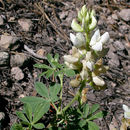Physical Description
provided by USDA PLANTS text
Perennial, Herbs, Tapr oot present, Nodules present, Stems erect or ascending, Stems less than 1 m tall, Stems solid, Stems or young twigs glabrous or sparsely glabrate, Stems or young twigs sparsely to densely hairy, Stem hairs hispid to villous, Stems hairs pilose or spreading, Leaves alternate, Leaves petiolate, Stipules conspicuous, Stipules setiform, subulate or acicular, Stipules persistent, Stipules adnate to petiole, Leaves compound, Leaves palmately 5-11 foliate, Leaf or leaflet margins entire, Leaflets 5-9, Leaves hairy on one or both surfaces, Inflorescences racemes, Inflorescence terminal, Bracts conspicuously present, Bracts very small, absent or caducous, Bracteoles present, Flowers zygomorphic, Calyx 5-lobed, Calyx 2-lipped or 2-lobed, Calyx hairy, Petals separate, Corolla papilionaceous, Petals clawed, Petals orange or yellow, Petals blue, lavander to purple, or violet, Banner petal ovoid or obovate, Wing petals narrow, oblanceolate to oblong, Wing tips obtuse or rounded, Keel pet als auriculate, spurred, or gibbous, Stamens 9-10, Stamens or anthers dimorphic, alternating large and small, Stamens monadelphous, united below, Filaments glabrous, Style terete, Fruit a legume, Fruit unilocular, Fruit freely dehiscent, Fruit elongate, straight, Fruit oblong or ellipsoidal, Fruit exserted from calyx, Fruit internally septate between the seeds, Fruit hairy, Fruit 3-10 seeded, Seeds ovoid to rounded in outline, Seed surface smooth, Seeds olive, brown, or black, Seed surface mottled or patchy.
Lupinus andersonii: Brief Summary
provided by wikipedia EN
Lupinus andersonii is a species of lupine known by the common name Anderson's lupine.
- license
- cc-by-sa-3.0
- copyright
- Wikipedia authors and editors

